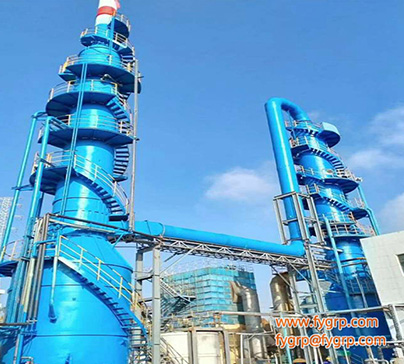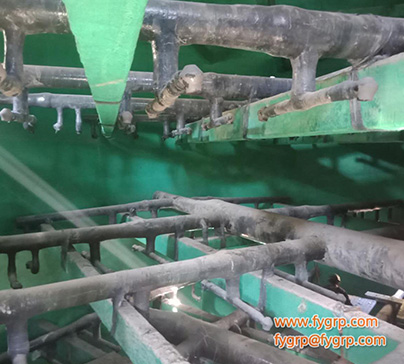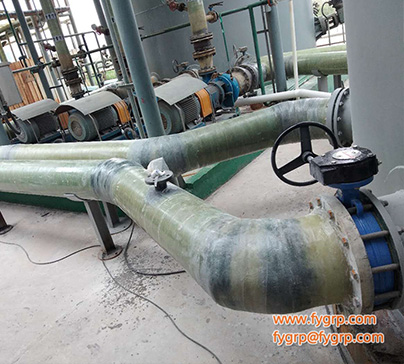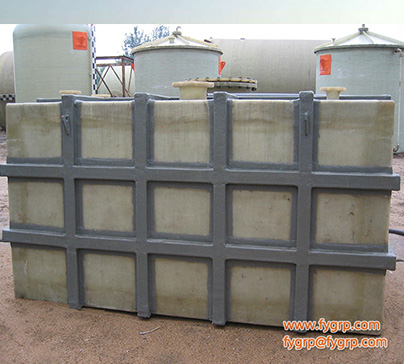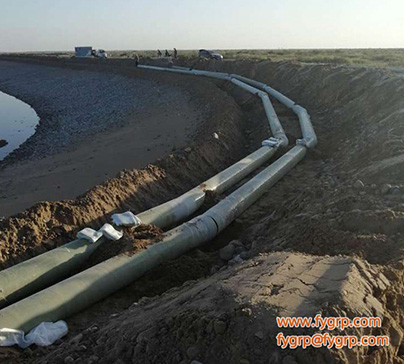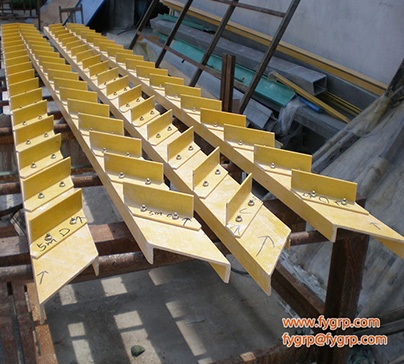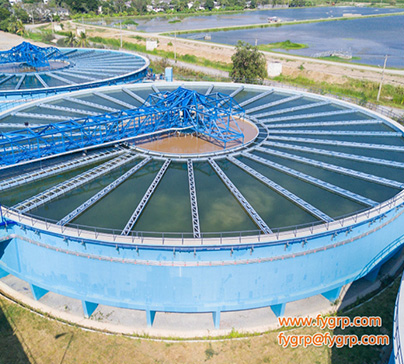
FRP stack
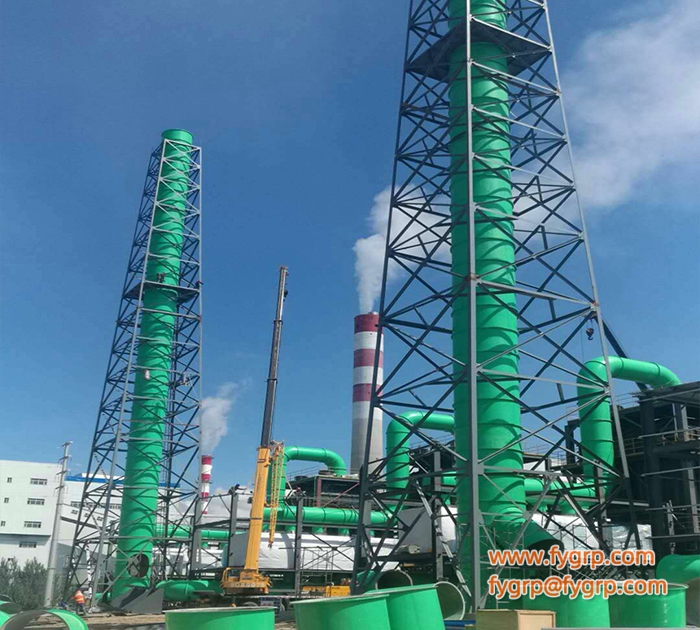
Stack is the main way to discharge coal waste gas in industries such as thermal power plant and metallurgy etc. Power plant for instance, In the past, the thermal power industry often only dedust to waste gas and coal, i.e. exhaust waste gas into surrounding atmosphere through tall stack. Nowadays, due to the requirement of environment protection that strictly control sulfur dioxide emission, the waste gas needs to be desulphurized. At present, thermal power industry mostly uses wet desulfurization. Before using wet desulfurization process, the flue gas contains more sulfur dioxide, but the temperature of flue gas entering the stack is high, as high as 130~160℃, and only has a small amount of flue gas condensation phenomenon, so it is not very high to anti-corrosion requirement of the stack. However, after wet desulfurization, the flue gas temperature drops to 50~80℃, and the moisture content is high, which accordingly leads to increase of corrosion rate of stack inside wall. Although the flue gas temperature after wet desulfurization drops to 50-80℃, during stack design, the flue gas temperature (about 150℃) without wet desulfurization under emergency and accident temperature (nearly 200℃) should be also considered. So the stack of wet desulfurization has higher requirements to corrosion and temperature resistance.
Engineer in domestic and abroad have done a lot of research and engineering tests In order to solve the problem of serious corrosion to the stack inside wall caused by installing the device for wet desulfurization. Currently, the Anticorrosive materials commonly used in stack includes acid-resistant brick - acid-resistant cement, steel-titanium composite structure, steel-stainless steel composite structure, steel-coating material and hard E-276 alloy lining etc. The new type of FRP stack, compared with others, has advantages of corrosion resistance, low investment, short construction period, light weight and long service life etc.
1.Application of FRP stack
FRP stack is used in wet desulfurization system and the whole unit after reasonable design, manufacture and installation. It has distinct technical economic and social benefits, long service life and reliable operation. It has been widely used in foreign countries and the technical and economic analysis is feasible.
Using FRP instead of traditional alloy steel, carbon steel lined with rubber and carbon steel coated with resin scales inside and other materials. The flue gas desulfurization unit, having advantages of strong corrosion resistance, long life, high strength and energy saving etc., provides the way for reducing the cost of desulfurization equipment domesticization.
2.Advantages and disadvantages of FRP stack and other materials
1). FRP stack
(1) Excellent corrosion resistance. The flue gas contains much of HCl, H2SO4, and other strong chemicals. FRP stack has excellent corrosion resistance to these chemicals.
(2) Integral structure, no corrosion weak point
(3) High performance cost ratio, low cost for the whole life
(4) No need to maintain for a long time, high temperature resistance
(5) Good designability. It can be customized according to the different requirements of customers.
2).Titanium (nickel) alloy composite steel plate lining
Excellent anti-corrosion performance, weld area is easy to corrode, the price is expensive
3). Steel inner barrel
(1) Foamed glass brick is good corrosion resistance, Construction process is complex and manufacture period is long
(2) Cover anti-corrosion concrete. Construction condition is bad and process is complex.
(3) Cover high performance heat and acid resistant coating. Service life is short and maintenance of complex.
(4) The period is longer that manufacture exhaust stack of laying glazed acid-proof brick.
3.Structural type of FRP stack
1).FRP lining concrete stack
It is mainly used as inner barrel of concrete stack with exhaust flue gas of 100m-200m height.
In this construction, fully use of characteristics of FRP such as high temperature and corrosion resistance. Concrete stack provides support, one concrete stack with one or two or three FRP inner barrel, which is determined according to design and requirement of owner.
The structure of concrete with FRP inner barrel generally adopts section hanging wall type. Embed steel structure as support system inside concrete stack. Generally 30-50 meters is as a section, it is connected with expansion joints between two sections, and set a guide support every 15m.
First step: Carry the first pipe section of stack inner barrel to the stack bottom by flat trailer.
Second step: Connect the first stack inner barrel and lifting sling. Lift pipe section bottom upto the height of connecting platform.
Third step: Carry the second pipe section of stack inner barrel by flat trailer and adjust position to align with the first section.
Fourth step: Complete butt joint of the first and second section. Remove the sling on the first section, lift the first and second section using the lifting ring on the second section.
Fifth step: Lift the first and second section that well connected to the place of connecting platform.
Sixth step: Connect the new pipe section to the above mentioned section. Repeat the third, fourth and fifth step.
Seventh step: Adjust up and down position of inner barrel with lifting equipment, support pipe section is matched and fixed with support steel platform.
2).FRP stack covered steel structure outside
The design height for FRP stack covered steel structure outside generally is less than 100m. design with desulfurizing tower. The stack is directly placed the outlet of tower. The design of this kind of stack doesn’t need to section, the weight of stack can directly transmit to desulfurizing tower or to steel structure. If stack weight is born by steel structure, the stack should be section and connected with expansion joint.
Installation step and procedure
(1)Prefabricate FRP stack and steel support
(2)Section lifting and fix for CS support
(3)Simultaneously section lifting and fixing of FRP stack
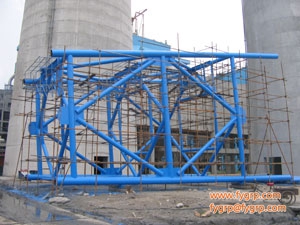
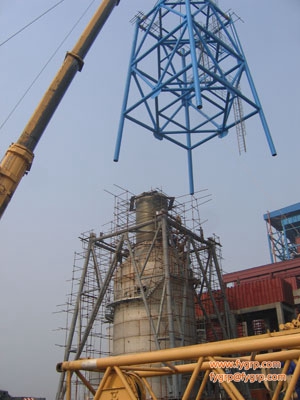

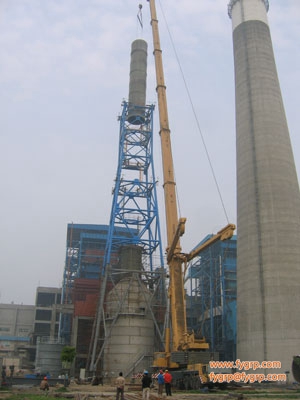

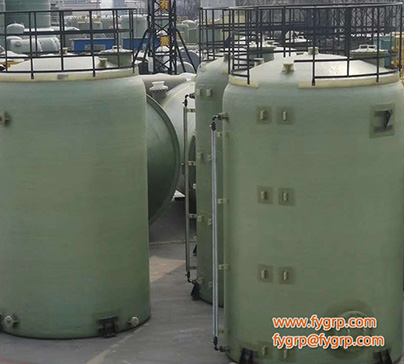
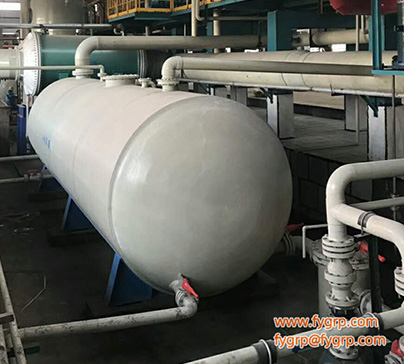


![[pics:title]](/static/upload/image/20200807/1596737624828019.jpg)
![[pics:title]](/static/upload/image/20200807/1596737624951838.jpg)
![[pics:title]](/static/upload/image/20200807/1596737624454102.jpg)
![[pics:title]](/static/upload/image/20200921/1600697674536466.jpg)
![[pics:title]](/static/upload/image/20200921/1600697674216287.jpg)
![[pics:title]](/static/upload/image/20200921/1600697674949388.jpg)
